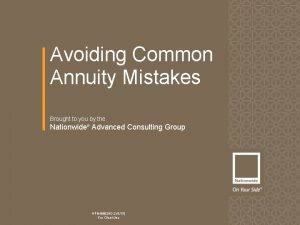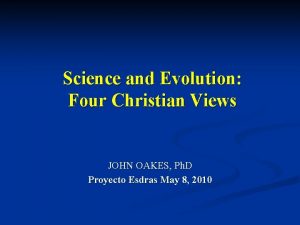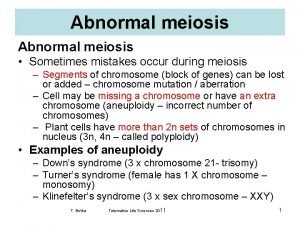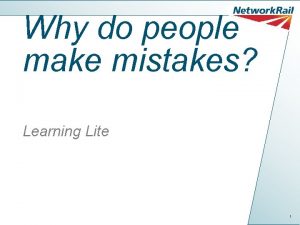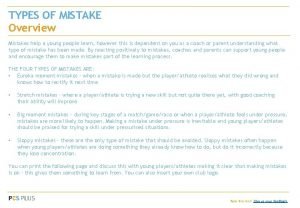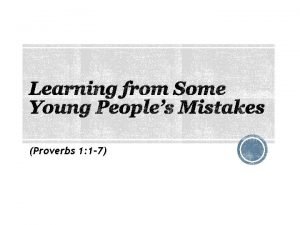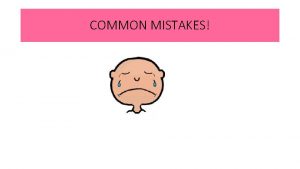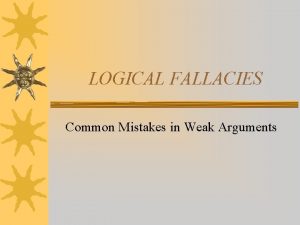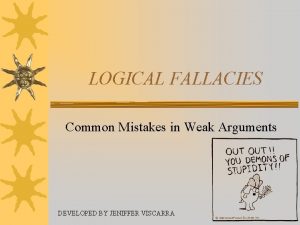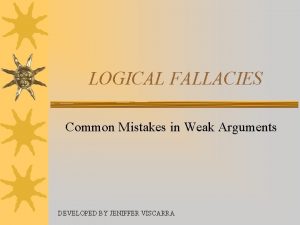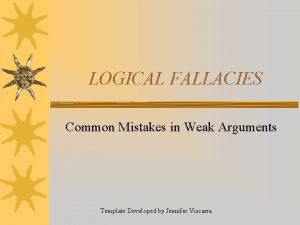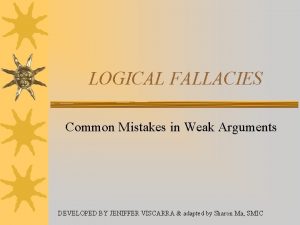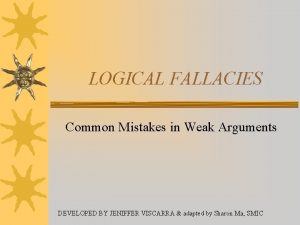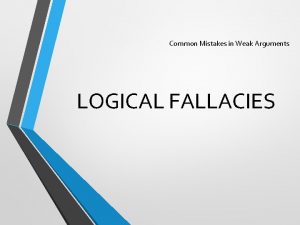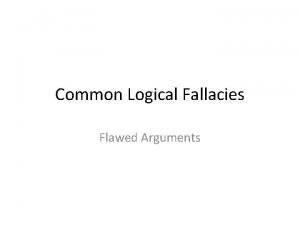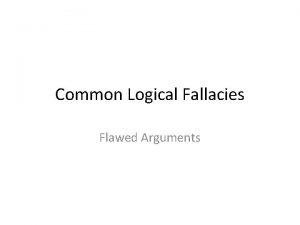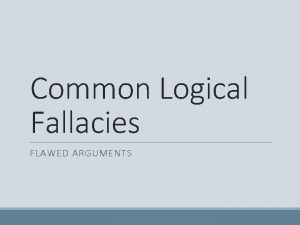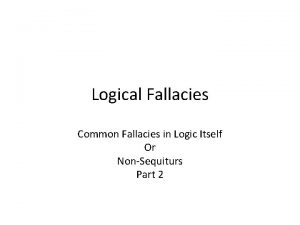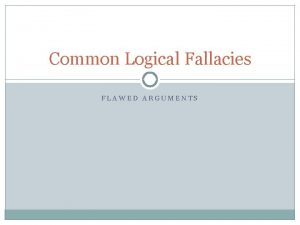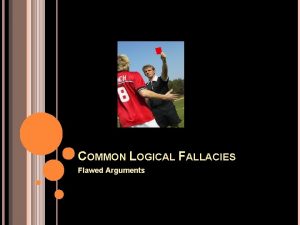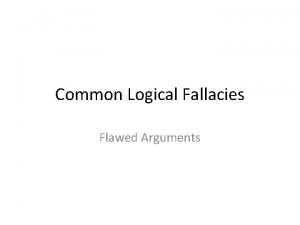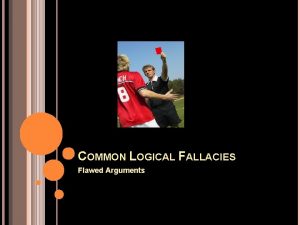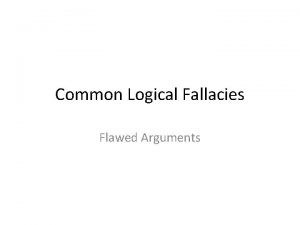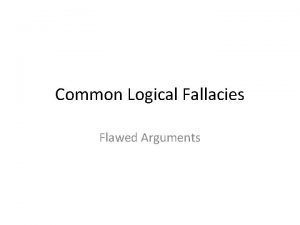Fallacies Introducing fallacies Fallacies are common mistakes of
































- Slides: 32

Fallacies

Introducing fallacies Fallacies are common mistakes of reasoning. They crop up all the time in everyday situations. Being alive to when people are committing fallacies is a good way to start thinking critically about arguments. Fallacies are by no means the only ways in which reasoning can go wrong, and neither are they necessarily the most egregious. But knowing them and keeping an eye out for them can nevertheless be handy.

Introducing fallacies In the next couple of sessions we’ll be going over some classic fallacies. It is not a complete list (there is no such thing!) but these examples will hopefully be illustrative of the sort of things that we watch out for when we’re thinking critically about reasoning. We’ll start slow, to get the hang of things, then speed up.

Denying the antecedent ‘Denying the antecedent’ is a fallacy that concerns arguments that use conditionals – that is, statements of the form ‘If… then…’ It’s basic form goes like this: ‘If (something), then (something else). But it is not the case that (something). So it is not the case that (something else). Or: If P then Q. But not P. So not Q.

Denying the antecedent (In a conditional, the first part (which comes after ‘if’) gets called the antecedent, whilst the second part (which comes after ‘then’) gets called the consequent. Which is why we call this fallacy ‘denying the antecedent’ – you assert a conditional, then deny the antecedent, and then conclude the denial of the consequent. )

Denying the antecedent This pattern of reasoning is fallacious. If you assert ‘if (something) then (something else)’, and then deny that (something) it doesn’t follow that (something else) might not still be true! This might sound confusing, but an example will help.

Denying the antecedent Consider the following argument: ‘If I teach you to ride a bike, you’ll be able to ride a bike. But I’m not going to teach you to ride a bike. So you won’t be able to ride a bike. ’ A conditional is asserted. Then the antecedent is denied. And then the denial of the consequent is concluded.

Denying the antecedent But the argument isn’t valid! Because we can imagine a situation in which the premises are both true but the conclusion is still false. Assume it’s the case that if I teach you to ride a bike, you’ll be able to ride a bike. And assume too that I won’t teach you to ride a bike. Then it might nevertheless be the case that you’ll be able to ride a bike – after all someone else might teach you, or you might teach yourself.

Denying the antecedent A conditional says that if the antecedent is true then the consequent will be true too. But it doesn’t say that’s the only way that the consequent can be true. The consequent might nevertheless be true by some other means, in which the antecedent is false. So denying the antecedent is a fallacious form of reasoning. Just because if P then Q and it is not the case that P, it doesn’t follow that it is not the case that Q!

Affirming the consequent is a very similar mistake of reasoning to denying the antecedent. But instead of denying the antecedent and then inferring the denial of the conclusion, you affirm the consequent and then infer the affirmation of the antecedent. You say: if (something) then (something else), and (something else) so it must be the case that (something). Or using letters: if P then Q, and Q – so P.

Affirming the consequent And this form of reasoning is fallacious for just the same reason as denying the antecedent is. Just because if P then Q is true, and Q is true too it doesn’t mean that P has to be true. P might be false, and Q might be true for some other reason than P. Let’s look back at our example.

Affirming the consequent ‘If I teach you to ride a bike, you’ll be able to ride a bike. You will be able to ride a bike. So it must be truth that I will teach you to ride a bike. ’ The conditional is asserted, and then the consequent is affirmed. And then the antecedent is concluded. So this is the right pattern of reasoning. But again the argument is not valid – this is a fallacy.

Affirming the consequent And the same counterexample we used before will work again here. Imagine that it is true that if I teach you to ride a bike you will be able to ride a bike. Imagine too that I won’t teach you to ride a bike. And imagine that someone else will teach you to ride a bike, so you become able to ride a bike. Then it’s true if I teach you will be able to ride. And that you will be able to ride. But it’s not true that I will teach you to ride!

Affirming the consequent In schematic terms, the counterexample shows that it is possible that if P then Q is true, and that Q is true, and yet that P is false. I. e. it shows that the pattern of reasoning that we call affirming the consequent is not valid – that it is a fallacy.

The composition fallacy consists of the assumption that if every component of a whole has a particular feature, then the whole must also have that feature. Whilst this assumption might be warranted in some cases, it is not always true. So assuming it can lead to errors of reasoning.

Examples of the composition fallacy Atoms are not alive. Every human is made up of atoms. So no human is alive. If any of the athletes runs twice as fast they will win the race. So if all the athletes run twice as fast, they will all win the race. Every member of the band has been to Boston. So the band has been to Boston.

The division fallacy is very similar to the composition fallacy. But while the composition fallacy wrongly assumes that the whole will exhibit all the properties of its parts, the division fallacy assume that the parts will all exhibit the properties of the whole. Again, though this assumption might be true in some cases, it doesn’t always hold, so assuming it can amount to a fallacy.

Examples of the division fallacy The USA is a rich country. So every US citizen must be rich. The UK consumes a lot of beef. Callum lives in the UK. So Callum must consume a lot of beef. Manchester United are extremely famous. So James Garner must be extremely famous.

Begging the question is a fallacious mode of reasoning whereby the conclusion is assumed as a premise. It is a form of circular reasoning. You assume something, and then infer that same thing – so you end up back where you started! Begging the question is fallacious because it makes it look as if an independent reason is being given for the conclusion. But in fact the conclusion is just being asserted without further argument.

Examples of begging the question The bible must be true. Because the bible doesn’t lie. My dad’s roast potatoes are the best. Because no one makes them better than him. You’re not allowed to do that because it’s prohibited.

False dichotomy A false dichotomy is when two options are presented as being the only two options, when in fact there are others available. (We are told A or B, but in fact C or D are also possibilities. ) Sometimes it is also used for situations in which two options are presented as being mutually incompatible, when in fact they might overlap. (It might not be that we have to A or B – we might be able to have both!)

Examples of false dichotomy You either believe God exists or you believe God doesn’t exist. Jess doesn’t believe God exists so she must believe God doesn’t exist. You can either take me at my word or not believe a word I say – and you wouldn’t be so mean as to disbelieve everything I say. You can either have good public services or low unemployment. And surely you don’t want high unemployment, so you must agree that we should cut public services.

Fallacy of equivocation In natural languages there are words and phrases that are ambiguous between two or more meanings. These are words like ‘bank’ (which can mean financial institution or riverside) or ‘jackass’ (which can mean male donkey or idiot). Sometimes arguments can falsely trade on these ambiguities – manipulating them to give the illusion of validity. Arguments that do this commit the fallacy of equivocation.

Examples of the fallacy of equivocation Jackasses have long ears. Dan is a jackass. So Dan has long ears. Nothing is better than a nice walk. A beer is better than nothing. So a beer is better than a nice walk. One is a number. And two is a number. So one is two.

The Ad Hominem fallacy Ad hominem is Latin for ‘to the person’ – and the ad hominem fallacy refers to the practice of dismissing an argument on the grounds of who happened to make that argument. The strength of the reasons given are independent of who happened to give them, so to dismiss the reasons on the basis of criticism of the person who gave them is fallacious.

Examples of the ad hominem fallacy Karl Marx argued that capitalism has many negative consequences. But that can’t be right – he himself enjoyed many of the benefits of capitalism. Senator Smith must be wrong to think that inflation will go down. He’s a lousy crook!

False cause fallacy (or post hoc ergo propter hoc) The Latin literally means ‘after the thing, therefore because of the thing’. This is a very common mistake, particularly in statistical reasoning. People assume that if something happened after something else, the first thing must have caused it. But that’s poor reasoning – it might be a coincidence, or there might be some third thing causing both of them. Correlation does not necessarily mean causation.

Examples of the false cause fallacy After my tax cuts, unemployment has gone down two percentage points! So tax cuts must create jobs.

Fallacy of hasty generalization Hasty generalization is basically just bad inductive reasoning. On the basis of a small number of cases, some general claim is made about a vast group. To substantiate general claims, you need lots of evidence conducted at a big scale. Small sample sizes are susceptible to all sorts of distortions. So hasty generalization is a fallacious mode of reasoning.

Examples of hasty generalization I knew a guy called Tommy at high school and he was a pain in the ass. So all people called Tommy must be pains in the ass. Luka Modric is an excellent footballer. So all Croatians must be excellent footballers. I went to Shanghai once and it was over 100 degrees. So China must be a really hot place.

False analogy Often people argue by comparing one thing with another, and then drawing some conclusion from the comparison. When this is done there is always the possibility that fallacious reasoning will creep in – if things are similar in one respect but not another. Analogies can help us think clearly about things, but they can also mislead.

Examples of false analogy The universe is a complex system, like a watch. Watches are made by watchmakers. So the universe too must have a creator. The body politic is like the human body. So all political organizations must age and eventually deteriorate.
 Antigentest åre
Antigentest åre Structural errors in writing
Structural errors in writing Common algebra mistakes
Common algebra mistakes 10 common communication mistakes
10 common communication mistakes What are the factors for 54
What are the factors for 54 Common factors of 36 and 48
Common factors of 36 and 48 Factors of 12 and 42
Factors of 12 and 42 Common anode and common cathode
Common anode and common cathode Highest common factors and lowest common multiples
Highest common factors and lowest common multiples Hcf 60 and 72
Hcf 60 and 72 Song with alliteration
Song with alliteration Power bi mistakes to avoid online courses
Power bi mistakes to avoid online courses Annuity mistakes
Annuity mistakes Adlerian theory key concepts
Adlerian theory key concepts Scientific mistakes in the bible
Scientific mistakes in the bible Rewrite the following statements in reported speech
Rewrite the following statements in reported speech Each of the following answers has two mistakes
Each of the following answers has two mistakes Biggest mistakes product management
Biggest mistakes product management Data warehouse optimization mistakes
Data warehouse optimization mistakes Sometimes mistakes
Sometimes mistakes Computer waste and mistakes
Computer waste and mistakes Mistakes images
Mistakes images We all make mistakes
We all make mistakes Harolds mistakes in the battle of hastings
Harolds mistakes in the battle of hastings Strengths and weaknesses of adlerian therapy
Strengths and weaknesses of adlerian therapy Find six mistakes in robin's spelling test
Find six mistakes in robin's spelling test Types of mistake
Types of mistake Look and find the mistakes
Look and find the mistakes Proverbs about learning from mistakes
Proverbs about learning from mistakes Top 10 mistakes leaders make
Top 10 mistakes leaders make Top 10 mistakes pastors make
Top 10 mistakes pastors make Difference between entrepreneurs and managers
Difference between entrepreneurs and managers Mistakes are the portals of discovery meaning
Mistakes are the portals of discovery meaning












